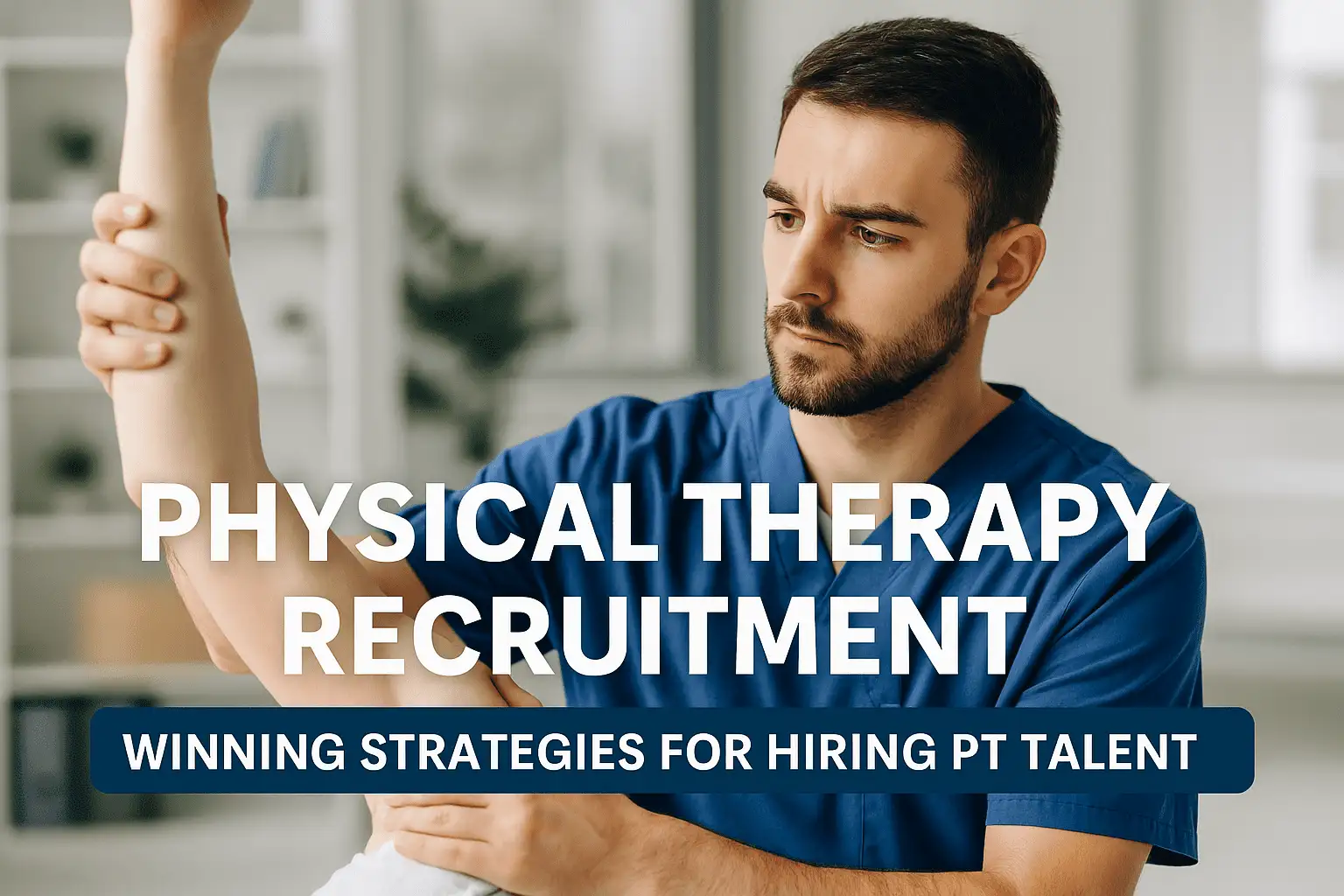Unlocking Success: Healthcare Recruiter Metrics Every Company Needs
The Importance of Healthcare Recruiter Metrics
In the realm of healthcare recruitment, metrics play a crucial role in evaluating the effectiveness and success of a healthcare recruiter. By analyzing and tracking relevant metrics, companies can gain valuable insights into their recruitment processes, make data-driven decisions, and optimize their strategies. This section explores why metrics matter in healthcare recruitment and how they drive success in this specialized field.
Why Metrics Matter in Healthcare Recruitment
Metrics provide a quantitative framework for assessing the performance and efficiency of healthcare recruiters. They offer concrete data on various aspects of the recruitment process, allowing companies to identify strengths, pinpoint areas for improvement, and make informed decisions. Here are a few reasons why metrics matter in healthcare recruitment:
- Performance Evaluation: Metrics enable companies to objectively evaluate the performance of healthcare recruiters, helping to identify top performers and areas where additional support or training may be needed.
- Process Improvement: By tracking metrics, companies can identify bottlenecks and inefficiencies in the recruitment process, leading to targeted improvements and streamlined workflows.
- Data-Driven Decision Making: Metrics provide valuable insights that guide decision-making in recruitment strategies, resource allocation, and budget planning. Data-driven decisions are more likely to yield positive outcomes and better align with organizational goals.
- Benchmarking and Comparison: Metrics allow companies to benchmark their performance against industry standards and compare their results with competitors. This helps identify areas where they excel or lag behind, fostering a culture of continuous improvement.
How Metrics Drive Success in Healthcare Recruitment
Metrics serve as a compass for healthcare recruiters, guiding them toward success. By leveraging the power of data, healthcare recruiters can make strategic decisions and optimize their efforts to attract and retain top talent. Here are a few ways in which metrics drive success in healthcare recruitment:
- Efficiency and Time Management: Metrics such as Time to Fill (TTF) provide insights into the time taken to fill job vacancies. By monitoring TTF and identifying factors that influence it, recruiters can streamline their processes, reduce time-to-hire, and ensure the timely placement of qualified candidates.
- Quality of Hire: Metrics related to Quality of Hire help recruiters assess the effectiveness of their talent acquisition strategies and the caliber of candidates they bring on board. Evaluating quality of hire enables recruiters to refine their sourcing methods, improve candidate screening processes, and enhance overall recruitment outcomes.
- Candidate Satisfaction: Metrics that measure Candidate Satisfaction shed light on the candidate experience throughout the recruitment journey. By collecting feedback and actively enhancing the candidate experience, recruiters can build a positive employer brand, attract top talent, and increase retention rates.
- Cost Efficiency: Metrics such as Cost per Hire provide valuable insights into the cost-effectiveness of recruitment activities. By tracking cost per hire and identifying cost drivers, recruiters can optimize their resources, prioritize cost-effective channels, and achieve maximum return on investment.
By embracing and leveraging healthcare recruiter metrics, companies can continuously improve their recruitment practices, enhance candidate experiences, and ultimately build a high-performing healthcare workforce. The subsequent sections will delve into specific metrics that are essential to track in healthcare recruitment, providing a comprehensive understanding of their significance and strategies for optimization.
Key Metrics to Track
In the world of healthcare recruitment, tracking key metrics is essential for evaluating the effectiveness of your hiring processes and driving success. By analyzing these metrics, companies can make data-driven decisions to streamline their recruitment strategies and attract the best talent. Four important metrics to track in healthcare recruitment are Time to Fill, Quality of Hire, Candidate Satisfaction, and Cost per Hire.
Time to Fill
Time to Fill refers to the duration it takes to fill a job opening from the moment it is posted until the candidate is hired. This metric is crucial as it impacts operational efficiency and patient care. A lengthy time to fill can lead to increased workload for existing staff and potential gaps in patient services.
To calculate time to fill, subtract the date the job opening was posted from the date the candidate accepted the offer. This metric can be further segmented by job role or department to identify areas that require improvement. By analyzing the factors that contribute to a longer time to fill, such as complex job requirements or a shortage of qualified candidates, recruiters can develop strategies to expedite the hiring process.
Quality of Hire
The Quality of Hire metric evaluates the overall performance and fit of candidates who have been hired. It measures how well a new employee meets or exceeds expectations in their role. Assessing the quality of hire is crucial to ensure that the selected candidates are not only technically competent but also aligned with the organization’s culture and values.
The evaluation of quality of hire can be done through various methods, including performance reviews, manager assessments, and employee feedback. Regularly soliciting feedback from hiring managers and team members can provide valuable insights into the success of the recruitment process. To enhance the quality of hire, recruiters can refine their candidate screening methods, conduct thorough interviews, and assess cultural compatibility during the selection process.
Candidate Satisfaction
Candidate Satisfaction measures the level of satisfaction experienced by candidates throughout the recruitment process. It encompasses their perception of the organization’s professionalism, communication, and overall recruitment experience. Positive candidate experiences can enhance the employer brand and attract top talent in the competitive healthcare industry.
Collecting candidate feedback through surveys or interviews can help gauge their satisfaction levels. This feedback can shed light on areas that need improvement, such as communication timeliness, transparency in the recruitment process, or interview experience. By addressing these pain points, recruiters can enhance the candidate experience, strengthen the employer brand, and increase the likelihood of attracting high-quality candidates.
Cost per Hire
Cost per Hire is a metric that quantifies the expenses incurred during the recruitment process. It includes costs associated with advertising job postings, recruiter salaries, applicant tracking systems, background checks, and other recruitment-related expenses. Monitoring cost per hire is essential for managing recruitment budgets and optimizing the allocation of resources.
To calculate cost per hire, add up all the expenses related to recruitment and divide it by the number of hires within a specific time frame. This metric allows companies to identify cost-saving opportunities and evaluate the efficiency of their recruitment strategies. Streamlining processes, leveraging technology, and implementing cost-effective recruitment strategies can help reduce the overall cost per hire.
By tracking these key metrics, healthcare organizations can gain valuable insights into their recruitment processes and make informed decisions to improve efficiency, attract top talent, and drive success in their recruitment efforts.
Measuring Time to Fill
When it comes to healthcare recruitment, time to fill is a critical metric that provides insights into the efficiency of the hiring process. Measuring time to fill helps organizations understand how long it takes to fill vacant positions, from the initial job posting to the candidate’s acceptance of the offer. This metric is essential for evaluating the effectiveness of recruitment strategies and identifying areas for improvement.
Definition and Calculation
Time to fill is defined as the number of days it takes to hire a candidate for a specific position. It is calculated by tracking the duration between the date the job opening is posted and the date the selected candidate accepts the job offer. The calculation includes the entire recruitment process, including sourcing candidates, conducting interviews, and completing necessary paperwork.
To calculate time to fill, use the following formula:
Time to Fill = Date of Candidate Acceptance – Date of Job Posting
For accurate calculations, it’s essential to consistently track the dates associated with each stage of the recruitment process.
Factors Affecting Time to Fill
Several factors can influence the time it takes to fill a healthcare position. These factors include:
- Job Market Conditions: The availability of qualified candidates in the job market can impact time to fill. A highly competitive market with a limited talent pool may result in longer recruitment cycles.
- Position Complexity: Positions that require specialized skills or qualifications may take longer to fill as it can be challenging to find candidates with the necessary expertise.
- Recruitment Process Efficiency: The efficiency of the recruitment process itself plays a significant role in time to fill. Streamlined processes, effective candidate screening, and timely decision-making can expedite the hiring timeline.
- Candidate Availability: The availability of candidates for interviews and their responsiveness to the recruitment process can impact time to fill. Delays caused by scheduling conflicts or prolonged candidate decision-making can extend the recruitment timeline.
Strategies to Improve Time to Fill
To reduce time to fill and optimize the recruitment process, organizations can implement several strategies:
- Streamline the Recruitment Process: Evaluate the recruitment process to identify areas of improvement and eliminate unnecessary steps. Simplifying the process can help accelerate hiring timelines.
- Proactive Talent Sourcing: Build a talent pipeline by proactively sourcing and engaging with potential candidates even before a position becomes vacant. This approach ensures a pool of qualified candidates is readily available when the need arises.
- Utilize Technology: Invest in applicant tracking systems (ATS) and other recruitment software that automate administrative tasks, enable efficient candidate tracking, and facilitate communication between recruiters and candidates.
- Improve Candidate Experience: Provide a positive and efficient candidate experience throughout the recruitment process. Promptly communicate with candidates, provide clear timelines, and offer feedback to ensure a smooth and transparent experience.
By measuring and analyzing time to fill, organizations can gain valuable insights into their recruitment process and make data-driven decisions to improve efficiency. Implementing strategies to reduce time to fill can help organizations secure top talent in a timely manner, contributing to the overall success of their healthcare recruitment efforts.
Assessing Quality of Hire
When it comes to healthcare recruitment, assessing the quality of hire is crucial for companies to ensure they are bringing in top talent. Quality of hire refers to the overall value and performance of a new hire in meeting the organization’s goals and expectations. It goes beyond technical skills and includes factors such as cultural fit, adaptability, and long-term potential.
Defining Quality of Hire
Defining quality of hire can vary from organization to organization. It often involves assessing how well a new hire aligns with the job requirements, their ability to contribute to the team and organization, and their potential for growth and development.
To measure quality of hire, companies can consider various factors such as job performance, retention rates, and feedback from managers and colleagues. It’s important to establish clear criteria and benchmarks to evaluate the quality of hire consistently across different roles and departments.
Methods for Evaluating Quality of Hire
There are several methods that companies can employ to evaluate the quality of hire. These methods can provide valuable insights into how well new hires are performing and contributing to the organization. Some common methods include:
- Performance Reviews: Regular performance evaluations allow managers to assess the quality of a new hire’s work and provide constructive feedback. These reviews can help identify areas for improvement and facilitate ongoing development.
- Manager Feedback: Gathering feedback from managers who work closely with the new hire can provide valuable insights into their performance, strengths, and areas of improvement. This feedback can be obtained through one-on-one discussions or structured feedback sessions.
- Peer Feedback: Seeking feedback from colleagues who interact with the new hire can provide additional perspectives on their teamwork, collaboration, and overall impact on the team. Peer feedback can be collected through surveys or informal discussions.
- Metrics and KPIs: Companies can track specific metrics and key performance indicators (KPIs) related to the new hire’s job responsibilities. These metrics can include productivity levels, customer satisfaction ratings, or any other relevant performance indicators.
Enhancing Quality of Hire
Enhancing the quality of hire requires a proactive approach to recruitment and onboarding processes. Here are some strategies that companies can implement to improve the quality of their hires:
- Effective Screening and Selection: Implementing rigorous screening and selection processes can help identify candidates who possess the necessary skills, experience, and cultural fit. This can involve conducting thorough interviews, assessments, and reference checks.
- Structured Onboarding Programs: Providing comprehensive onboarding programs can help new hires acclimate to the organization’s culture, job responsibilities, and expectations. Clear communication, mentorship, and training opportunities can contribute to a smoother transition and faster integration into the team.
- Ongoing Development and Support: Investing in the development and growth of new hires can enhance their skills and job performance. This can include providing access to training programs, mentorship opportunities, and regular performance feedback.
- Continuous Evaluation and Feedback: Regularly assessing and providing feedback on the new hire’s performance can help identify areas for improvement and foster ongoing development. This can be achieved through performance reviews, one-on-one meetings, or feedback sessions.
By focusing on the quality of hire, companies can ensure that they are attracting and retaining top talent in the healthcare industry. Continuously evaluating and enhancing the quality of hire contributes to the overall success and growth of the organization.
Evaluating Candidate Satisfaction
When it comes to healthcare recruitment, candidate satisfaction plays a crucial role in attracting top talent and maintaining a positive employer brand. Satisfied candidates are more likely to accept job offers, refer others, and speak positively about their experience, which can ultimately lead to a stronger pool of qualified candidates. In this section, we will explore the importance of candidate satisfaction, collecting feedback, and enhancing the candidate experience.
Importance of Candidate Satisfaction
Candidate satisfaction is not just a measure of how happy individuals are with their recruitment experience; it also reflects the effectiveness of the recruitment process and the overall employer brand. Satisfied candidates are more likely to view the organization in a positive light, which can have long-term benefits in terms of employee retention and engagement.
Positive candidate experiences can also lead to enhanced employer reputation and increased referrals. Candidates who have had a positive experience are more likely to recommend the organization to their network, expanding the reach of the recruitment efforts and potentially attracting high-quality candidates.
Collecting Feedback
To evaluate candidate satisfaction, it’s important to collect feedback throughout the recruitment process. This feedback can provide valuable insights into areas that require improvement and help identify trends or patterns in candidate experiences.
Feedback can be obtained through various methods, such as surveys, interviews, or focus groups. Online surveys can be an effective way to gather quantitative data, while interviews and focus groups allow for more in-depth qualitative feedback. It’s essential to ensure that the feedback collection process is anonymous to encourage honest responses.
Enhancing Candidate Experience
Once feedback has been collected, organizations can take steps to enhance the candidate experience and address any areas of concern. Here are some strategies to consider:
- Streamline the application process: Simplify and optimize the application process to minimize friction and ensure a user-friendly experience.
- Communication and transparency: Maintain regular communication with candidates, keeping them informed about the status of their application. Transparent communication can help manage candidate expectations and reduce anxiety.
- Personalization: Tailor the recruitment process to the individual candidate whenever possible. Personalized communication and interactions can make candidates feel valued and appreciated.
- Candidate-centric approach: Put the candidate’s needs at the forefront of the recruitment process. Ensure that interviews are conducted in a respectful and professional manner, and provide opportunities for candidates to ask questions and learn more about the organization.
- Timeliness: Strive to provide prompt feedback and updates to candidates. Delays in communication can create frustration and negatively impact the candidate experience.
By focusing on candidate satisfaction and continuously improving the recruitment process, healthcare organizations can attract and retain top talent, strengthen their employer brand, and build a positive reputation in the industry. Remember, a satisfied candidate today could be a valuable employee and advocate for your organization in the future.
Understanding Cost per Hire
To effectively manage the recruitment process and make informed decisions, it is essential for companies to understand the cost per hire metric. Calculating the cost per hire provides valuable insights into the financial investment required to bring new healthcare professionals on board. This metric helps organizations evaluate the efficiency and effectiveness of their recruitment efforts.
Calculating Cost per Hire
The cost per hire is determined by adding up all the expenses associated with the recruitment process and dividing that total by the number of hires made during a specific period of time. The formula for calculating the cost per hire is as follows:
Cost per Hire = (Total Recruitment Costs) / (Number of Hires)
The recruitment costs to consider include advertising expenses, recruitment agency fees, job board subscriptions, background checks, candidate travel expenses, and any other expenses directly related to the hiring process. By calculating the cost per hire, companies can gain a clearer understanding of the financial impact of their recruitment activities.
Factors Impacting Cost per Hire
Several factors can impact the cost per hire in healthcare recruitment. These factors include:
- Advertising and marketing: Companies that invest heavily in advertising and marketing campaigns may incur higher costs per hire. It is important to evaluate the effectiveness of different advertising channels and optimize strategies to minimize costs.
- Recruitment agencies: Engaging the services of healthcare recruiting agencies can significantly impact the cost per hire. These agencies often charge fees based on a percentage of the new hire’s salary. It is important to assess the value provided by recruitment agencies and consider alternative recruitment strategies if the costs outweigh the benefits.
- Time and resources: The time and resources invested in the recruitment process can also contribute to the cost per hire. This includes the hours spent by internal recruitment teams, interview panel members, and other stakeholders involved in the hiring process. Streamlining internal processes and utilizing technology can help optimize the allocation of resources.
Cost-Effective Recruitment Strategies
To optimize the cost per hire and improve the efficiency of healthcare recruitment, companies can implement cost-effective strategies. These strategies include:
- Employee referrals: Offering incentives for employee referrals can be a cost-effective way to attract qualified candidates. Current employees can serve as valuable brand ambassadors and help identify potential candidates within their networks.
- Utilizing online job boards: Online job boards provide a cost-effective platform for advertising job openings. Companies can target specific healthcare professionals and reach a broader audience using these platforms.
- Building a talent pipeline: By proactively building relationships with potential candidates and maintaining a talent pipeline, companies can reduce recruitment costs. This approach allows organizations to have a pool of qualified candidates readily available when positions become available.
- Employer branding: Establishing a strong employer brand can attract top talent and reduce recruitment costs in the long run. A positive reputation and strong company culture can make the organization more appealing to potential candidates, reducing the need for extensive advertising and recruitment efforts.
By understanding the cost per hire metric and implementing cost-effective recruitment strategies, companies can optimize their recruitment processes and make informed decisions. Regularly monitoring and analyzing this metric can help organizations identify areas for improvement and allocate resources more effectively, ultimately leading to successful healthcare recruitment outcomes.
Leveraging Metrics for Success
To achieve success in healthcare recruitment, leveraging metrics is essential. By analyzing and utilizing data, companies can make informed decisions and drive continuous improvement in their recruitment processes. Here are three key ways to leverage metrics for success: leveraging data for continuous improvement, setting goals and targets, and implementing actionable insights.
Leveraging Data for Continuous Improvement
Metrics provide valuable insights into the effectiveness of healthcare recruitment efforts. By regularly monitoring and analyzing metrics such as time to fill, quality of hire, candidate satisfaction, and cost per hire, companies can identify areas for improvement and make data-driven decisions.
Analyzing data on time to fill helps companies evaluate the efficiency of their recruitment process. It provides insights into the average time it takes to fill open positions, allowing companies to identify bottlenecks and streamline their hiring process. For more information on measuring time to fill, refer to our article on healthcare recruiter metrics.
Setting Goals and Targets
Setting clear and measurable goals is crucial for success in healthcare recruitment. Based on the metrics tracked, companies can set goals and targets that align with their recruitment objectives. For example, a company may aim to reduce the average time to fill by a certain percentage or increase candidate satisfaction scores.
By setting specific, achievable, and time-bound goals, companies can keep their recruitment efforts focused and ensure continuous improvement. These goals provide a roadmap for success and allow companies to track their progress over time.
Implementing Actionable Insights
Metrics provide valuable insights, but they are only meaningful if acted upon. Companies should use the insights gained from analyzing metrics to implement actionable strategies and improvements. For example, if the quality of hire metric indicates room for improvement, companies can enhance their selection and assessment processes to ensure they are attracting and hiring top talent.
Regularly reviewing metrics and implementing changes based on the insights gained helps companies optimize their recruitment efforts and achieve their goals. It’s important to have a feedback loop in place, allowing recruiters and hiring managers to provide input and suggestions for improvement based on their experiences.
By leveraging metrics for continuous improvement, setting goals and targets, and implementing actionable insights, companies can enhance their healthcare recruitment processes and drive success in attracting and hiring skilled healthcare professionals. It’s important to regularly review and adapt recruitment strategies based on the insights gained from metrics to stay competitive in the industry.






